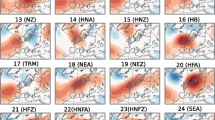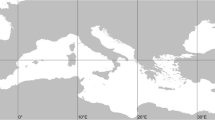Abstract
Using data from the International Satellite Cloud Climatology Project (ISCCP), we examine how near-global (60°N–60°S) high cloud fraction varies over time in the past three decades. Our focus is on identifying dominant modes of variability and associated spatial patterns, and how they are related to sea surface temperature. By performing the principal component analysis, we find that the first two principal modes of high cloud distribution show strong imprints of the two types of El Niño–Southern Oscillation (ENSO)—the canonical ENSO and the ENSO Modoki. Comparisons between ISCCP data and 14 models from the Atmospheric Model Intercomparison Project Phase 5 (AMIP5) show that models simulate the spatial pattern and the temporal variations of high cloud fraction associated with the canonical ENSO very well but the magnitudes of the canonical ENSO vary among the models. Furthermore, the multi-model mean of the second principal mode in the AMIP5 simulations appears to capture the temporal behavior of the second mode but individual AMIP5 models show large discrepancies in capturing observed temporal variations. A new metric, defined by the relative variances of the first two principal components, suggests that most of the AMIP5 models overestimate the second principal mode of high clouds.








Similar content being viewed by others

References
Ackerman SA, Strabala KI, Menzel WP, Frey RA, Moeller CC, Gumley LE (1998) Discriminating clear sky from clouds with MODIS. J Geophys Res 103:32141–32157. doi:10.1029/1998JD200032
Ashok K, Behera SK, Rao SA, Weng HY, Yamagata T (2007) El Niño Modoki and its possible teleconnection. J Geophys Res 112:C11007. doi:10.1029/2006JC003798
Bjerknes J (1969) Atmospheric teleconnections from equatorial Pacific. Mon Weather Rev 97:163–172. doi:10.1175/1520-0493(1969)097<0163:ATFTEP>2.3.CO;2
Bony S et al (2015) Clouds, circulation and climate sensitivity. Nat Geosci 8:261–268. doi:10.1038/ngeo2398
Cattell RB (1966) The scree test for the number of factors. Multivar Behav Res 1:245–276. doi:10.1207/s15327906mbr0102_10
Cess RD et al (1989) Interpretation of cloud-climate feedback as produced by 14 atmospheric general-circulation models. Science 245:513–516. doi:10.1126/science.245.4917.513
Charney JG, Arakawa A, Baker DJ, Bolin B, Dickinson RE, Goody RM, Leith CE, Stommel HM, Wunsch CI (1979) Carbon dioxide and climate: a scientific assessment. The National Academies Press, Washington, DC, pp 34. doi:10.17226/12181
Chen MH, Rood RB, Read WG (1999) Seasonal variations of upper tropospheric water vapor and high clouds observed from satellites. J Geophys Res 104:6193–6197. doi:10.1029/1998JD200124
Dessler AE (2010) A determination of the cloud feedback from climate variations over the past decade. Science 330:1523–1527. doi:10.1126/science.1192546
Evan AT, Heidinger AK, Vimont DJ (2007) Arguments against a physical long-term trend in global ISCCP cloud amounts. Geophys Res Lett 34:L04701. doi:10.1029/2006GL028083
Gadgil S, Joseph PV, Joshi NV (1984) Ocean–atmosphere coupling over monsoon regions. Nature 312:141–143. doi:10.1038/312141a0
Gates WL (1992) AMIP: the atmospheric model intercomparison project. Bull Am Meteorol Soc 73:1962–1970. doi:10.1175/1520-0477(1992)073<1962:ATAMIP>2.0.CO;2
Graham NE, Barnett TP (1987) Sea surface temperature, surface wind divergence, and convection over tropical oceans. Science 238:657–659. doi:10.1126/science.238.4827.657
Gu GJ, Adler RF (2013) Interdecadal variability/long-term changes in global precipitation patterns during the past three decades: global warming and/or pacific decadal variability? Clim Dyn 40:3009–3022. doi:10.1007/s00382-012-1443-8
Hartmann DL, Larson K (2002) An important constraint on tropical cloud-climate feedback. Geophys Res Lett 29:1951. doi:10.1029/2002GL015835
Heidinger AK, Evan AT, Foster MJ, Walther A (2012) A naive Bayesian cloud-detection scheme derived from CALIPSO and applied within PATMOS-x. J Appl Meteorol Climatol 51:1129–1144. doi:10.1175/Jamc-D-11-02.1
IPCC (2013) Climate change 2013: the physical science basis. Contribution of working group I to the fifth assessment report of the intergovernmental panel on climate change. Cambridge University Press, Cambridge. doi:10.1017/CBO9781107415324
Jiang JH, Wang B, Goya K, Hocke K, Eckermann SD, Ma J, Wu D, Read WG (2004) Geographical distribution and interseasonal variability of tropical deep convection: UARS MLS observations and analyses. J Geophys Res 109:D03111. doi:10.1029/2003JD003756
Jiang JH et al (2012) Evaluation of cloud and water vapor simulations in CMIP5 climate models using NASA “A-Train” satellite observations. J Geophys Res 117:D14105. doi:10.1029/2011JD017237
Jiang JH et al (2015) Evaluating the diurnal cycle of upper-tropospheric ice clouds in climate models using SMILES observations. J Atmos Sci 72:1022–1044. doi:10.1175/JAS-D-14-0124.1
Kahn BH et al (2014) The atmospheric infrared sounder version 6 cloud products. Atmos Chem Phys 14:399–426. doi:10.5194/acp-14-399-2014
Klein SA, Zhang Y, Zelinka MD, Pincus R, Boyle J, Gleckler PJ (2013) Are climate model simulations of clouds improving? An evaluation using the ISCCP simulator. J Geophys Res 118:1329–1342. doi:10.1002/jgrd.50141
Kuang Z, Hartmann DL (2007) Testing the fixed anvil temperature hypothesis in a cloud-resolving model. J Clim 20:2051–2057. doi:10.1175/JCLI4124.1
Li Z, Niu F, Fan J, Liu Y, Rosenfeld D, Ding Y (2011) Long-term impacts of aerosols on the vertical development of clouds and precipitation. Nat Geosci 4:888–894. doi:10.1038/ngeo1313
Li J, Carlson BE, Rossow WB, Lacis AA, Zhang YC (2015) An intercomparison of the spatiotemporal variability of satellite- and ground-based cloud datasets using spectral analysis techniques. J Clim 28:5716–5736. doi:10.1175/JCLI-D-14-00537.1
Lindzen RS, Nigam S (1987) On the role of sea surface temperature gradients in forcing low-level winds and convergence in the tropics. J Atmos Sci 44:2418–2436. doi:10.1175/1520-0469(1987)044<2418:OTROSS>2.0.CO;2
Lohmann U, Rotstayn L, Storelvmo T, Jones A, Menon S, Quaas J, Ekman AML, Koch D, Ruedy R (2010) Total aerosol effect: radiative forcing or radiative flux perturbation? Atmos Chem Phys 10:3235–3246. doi:10.5194/acp-10-3235-2010
Luo ZZ, Rossow WB, Inoue T, Stubenrauch CJ (2002) Did the eruption of the Mt. Pinatubo Volcano affect cirrus properties? J Clim 15:2806–2820. doi:10.1175/1520-0442(2002)015<2806:DTEOTM>2.0.CO;2
McPhaden MJ, Lee T, McClurg D (2011) El Niño and its relationship to changing background conditions in the tropical Pacific. Geophys Res Lett 38:L15709. doi:10.1029/2011GL048275
Norris JR, Evan AT (2015) Empirical removal of artifacts from the ISCCP and PATMOS-x satellite cloud records. J Atmos Ocean Technol 32:691–702. doi:10.1175/JTECH-D-14-00058.1
Press WH, Teukolsky SA, Vetterling WT, Flannery BP (2007) Numerical recipes: the art of scientific computing, 3rd edn. Cambridge University Press, New York
Ramanathan V, Collins W (1991) Thermodynamic regulation of ocean warming by cirrus clouds deduced from observations of the 1987 El-Niño. Nature 351:27–32. doi:10.1038/351027a0
Rayner NA, Parker DE, Horton EB, Folland CK, Alexander LV, Rowell DP, Kent EC, Kaplan A (2003) Global analyses of sea surface temperature, sea ice, and night marine air temperature since the late nineteenth century. J Geophys Res 108:4407. doi:10.1029/2002JD002670
Rossow WB, Schiffer RA (1999) Advances in understanding clouds from ISCCP. Bull Am Meteorol Soc 80:2261–2287. doi:10.1175/1520-0477(1999)080<2261:AIUCFI>2.0.CO;2
Rossow WB, Walker AW, Garder LC (1993) Comparison of ISCCP and other cloud amounts. J Clim 6:2394–2418. doi:10.1175/1520-0442(1993)006<2394:COIAOC>2.0.CO;2
Saji NH, Goswami BN, Vinayachandran PN, Yamagata T (1999) A dipole mode in the tropical Indian Ocean. Nature 401:360–363. doi:10.1038/43855
Sassi F, Salby M, Read WG (2001) Relationship between upper tropospheric humidity and deep convection. J Geophys Res 106:17133–17146. doi:10.1029/2001JD900121
Sherwood SC, Bony S, Dufresne J-L (2014) Spread in model climate sensitivity traced to atmospheric convective mixing. Nature 505:37–42. doi:10.1038/nature12829
Smith GL, Rutan DA (2003) The diurnal cycle of outgoing longwave radiation from earth radiation budget experiment measurements. J Atmos Sci 60:1529–1542. doi:10.1175/2997.1
Soden BJ, Vecchi GA (2011) The vertical distribution of cloud feedback in coupled ocean–atmosphere models. Geophys Res Lett 38:L12704. doi:10.1029/2011GL047632
Stephens GL (1984) The parameterization of radiation for numerical weather prediction and climate models. Mon Weather Rev 112:826–867. doi:10.1175/1520-0493(1984)112<0826:TPORFN>2.0.CO;2
Su H, Jiang JH (2013) Tropical clouds and circulation changes during the 2006/07 and 2009/10 El Niños. J Clim 26:399–413. doi:10.1175/JCLI-D-12-00152.1
Su H, Neelin JD, Chou C (2001) Tropical teleconnection and local response to SST anomalies during the 1997–1998 El Niño. J Geophys Res 106:20025–20043. doi:10.1029/2000JD000124
Su H et al (2008a) Variations of tropical upper tropospheric clouds with sea surface temperature and implications for radiative effects. J Geophys Res 113:D10211. doi:10.1029/2007JD009624
Su H, Jiang JH, Vane DG, Stephens GL (2008b) Observed vertical structure of tropical oceanic clouds sorted in large-scale regimes. Geophys Res Lett 35:L24704. doi:10.1029/2008GL035888
Su H et al (2013) Diagnosis of regime-dependent cloud simulation errors in CMIP5 models using “A-Train” satellite observations and reanalysis data. J Geophys Res 118:2762–2780. doi:10.1029/2012JD018575
Takahashi H, Su H, Jiang JH, Luo ZJ, Xie SP, Hafner J (2013) Tropical water vapor variations during the 2006–2007 and 2009–2010 El Niños: satellite observation and GFDL AM2.1 simulation. J Geophys Res 118:8910–8920. doi:10.1002/jgrd.50684
Taylor KE, Stouffer RJ, Meehl GA (2012) An overview of CMIP5 and the experiment design. Bull Am Meteorol Soc 93:485–498. doi:10.1175/BAMS-D-11-00094.1
Tsushima Y, Iga S, Tomita H, Satoh M, Noda AT, Webb MJ (2014) High cloud increase in a perturbed SST experiment with a global nonhydrostatic model including explicit convective processes. J Adv Model Earth Syst 6:571–585. doi:10.1002/2013MS000301
Waliser DE, Graham NE, Gautier C (1993) Comparison of the highly reflective cloud and outgoing longwave radiation datasets for use in estimating tropical deep convection. J Clim 6:331–353. doi:10.1175/1520-0442(1993)006<0331:COTHRC>2.0.CO;2
Wilks DS (2006) Statistical methods in the atmospheric sciences. Academic Press, Burlington
Yeh S-W, Kug J-S, Dewitte B, Kwon M-H, Kirtman BP, Jin F-F (2009) El Niño in a changing climate. Nature 461:511–514. doi:10.1038/nature08316
Zelinka MD, Hartmann DL (2010) Why is longwave cloud feedback positive? J Geophys Res 115:D16117. doi:10.1029/2010JD013817
Zelinka MD, Klein SA, Taylor KE, Andrews T, Webb MJ, Gregory JM, Forster PM (2013) Contributions of different cloud types to feedbacks and rapid adjustments in CMIP5. J Clim 26:5007–5027. doi:10.1175/JCLI-D-12-00555.1
Zhang Y, Wallace JM, Battisti DS (1997) ENSO-like interdecadal variability: 1900–93. J Clim 10:1004–1020. doi:10.1175/1520-0442(1997)010<1004:ELIV>2.0.CO;2
Zhang MH et al (2005) Comparing clouds and their seasonal variations in 10 atmospheric general circulation models with satellite measurements. J Geophys Res 110:D15S02. doi:10.1029/2004JD005021
Zhao M (2014) An investigation of the connections among convection, clouds, and climate sensitivity in a global climate model. J Clim 27:1845–1862. doi:10.1175/JCLI-D-13-00145.1
Acknowledgments
TMC was supported by the 2013 Summer Undergraduate Research Fellowships at the California Institute of Technology. SNM was supported by the 2014 Summer Undergraduate Research Exchange Program at the Chinese University of Hong Kong. We thank Katie Antilla, Run-Lie Shia, and Edmund K.-M. Chang for their technical support and invaluable comments. We also thank Qiong Zhang, Sally Newman, and Mimi Gerstell for reading the manuscript. HS and JHJ acknowledge funding support from NASA Energy and Water Cycle Study (NEWS) program. They performed the work at Jet Propulsion Laboratory, California Institute of Technology, under contract with NASA. KFL was supported partly by the Jack Eddy Fellowship managed by the University Corporation for Atmospheric Research and party by the NASA Grant NNX14AR40G. YLY was supported by UHOUST.130027 subcontract from the University of Houston to Caltech. The monthly SST data and monthly ENSO index were provided by NOAA/OAR/ESRL, Boulder, Colorado, from their website (http://esrl.noaa.gov/psd/). The monthly ENSO Modoki index was provided by the Japan Agency for Marine-Earth Science and Technology (http://www.jamstec.go.jp/frcgc/research/d1/iod/modoki_home.html.en). The AMIP5 models were obtained from the CMIP5 model archive (http://cmip-pcmdi.llnl.gov/cmip5/).
Author information
Authors and Affiliations
Corresponding author
Rights and permissions
About this article
Cite this article
Li, KF., Su, H., Mak, SN. et al. An analysis of high cloud variability: imprints from the El Niño–Southern Oscillation. Clim Dyn 48, 447–457 (2017). https://doi.org/10.1007/s00382-016-3086-7
Received:
Accepted:
Published:
Issue Date:
DOI: https://doi.org/10.1007/s00382-016-3086-7



